The burnets were ubiquitous. I took them for granted, as I took the summer, with its warm, but not scorching temperatures―the sweet European summer which seems to have gone about forever today.
When I stepped down to the creek, I left swirling dots of light in my wake. I crossed through the vegetation on the riverbank, which below gave way to a wide bed. In its center, the water gurgled softly along boulders and swathes of gravel. On the sides, the mixture of sand and pebbles was loosely grown over with shrubs and flowers. Wild carrots held their white blossom disks into the morning air. Bird’s-foot trefoil pushed yellow calices forward along the soil, and common chicory reflected the June sky with pale blue florescences.
As I brushed along the plants, my movements seemed to shake light out of them. Flickers of green and sparks of crimson danced through the air. They spiralled around me and sunk back into the vegetation. The whole riverbank was flickering with colour. There were different hues of blossoms, swaying softly in the air. And there were those luminous spots bursting out of the plant cover and falling down again like flames sinking back into a fire. I felt as though I had entered a realm behind the usual appearances, and there everything was made of light.
The radiance of that other world was carried to me on the wings of hundreds of burnet moths. For the last eleven months, I had longed to meet the luminous insects again. They had suddenly disappeared last summer in mid-July, after their mating time was over. Burnets are among the crown jewels of the insect kingdom. They are closely related to the many inconspicuous grey and brown species of little moths, but look as different from their unobtrusive cousins as a glorious May morning from a gloomy November afternoon. Burnets seem to be made not of matter, but of colour alone. They don’t resemble butterflies, either, which are the closest relatives to moths in the insect realm, where both are grouped together as the Lepidoptera. Burnet moths are small, about one-third the length of your little finger. Their wings are not broad and leaf-like but elongated, which makes them resemble a colourful fly or wasp.
It is their colour that singles out burnets among other insects. They come in dark hues of iridescent blue and green, covered by spots or stripes of the most intense complimentary colours like raspberry pink or vanilla yellow. One could even think that their English name refers to this flickering display, which “burns” among the more steady green of the vegetation. But the name comes from the Old French term “brunet” (“brunete” in the feminine form), meaning a living being of brown colour―exactly as “brunette” does (which is the same word with the same meaning, assimilated from French into English at a later age).
Burnets are what we would have in hand if we were able to crystallise light. They are physical parts of the ecosystem, organic bodies that drink nectar, reproduce, and die, and they are also beyond anything physical, the antithesis of matter. Of course, they exist in time and space, but they are not only visible elements of material reality but rather they allow a glimpse into what visibility is about. Their luminosity touches us with the secret of why anything is visible at all. This secret was here, fluttering before my eyes, settling down on a spiny leaf, unfurling a slender black proboscis, and dipping it deeply into the nectar of a pink thistle blossom.
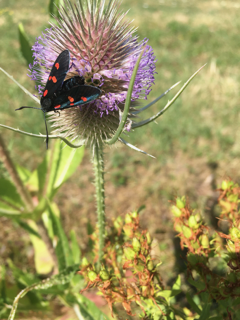
Burnets only fly for some short weeks in June and July. They break out unexpectedly like a flower bloom and populate weedy riverbanks and the fringes of mountain backroads. The moths mostly settle on the vegetation. If you pass, they fly up in a flash of colour. In the Apennines, burnets still exist in greater numbers. Once, they were a common sign of summer everywhere in Europe, even high up into its middle and northern latitudes. The flying gems marked those first nimble days when summer had really arrived, when the great heat had not yet kicked in, but everything prepared for warmth and ease and lightness.
Burnets are beautiful, and they are toxic. As often in the insect realm, particularly striking colours serve as a warning sign to predators that this food may not taste good or even might kill them (birds have been observed to throw up after devouring poisonous prey). The burnets’ beauty creates a tricky paradox. What might fill a human observer with glee signals mortal danger to other beings. Are the moths beautiful because they are toxic? Can bliss and pain be neatly sorted from one another? Can there be any objectivity to our experience of beauty? The burnet’s colours, lifted into the air on iridescent wings, amount to a single burning question: How does life come from death?
I remember boyhood days of early 1970s summers in landscapes filled with blossoms and whirling burnets. I remember rolling hills and little water courses and cows on pastures and open tractors without roofs where one could sit on the huge metal arches over the big wheels. And there were burnets all over. The colourful moths were part of the joy of life, not to be separated from it, amalgamated into its very structure, without any questions. You could say ‘burnet’ and you would speak summer.
In linguistics, this is called a metonymy―a single thing that stands for a world of meaning. Metonymies are more than symbols. They are not just images of language but real things, symbols not in the form of thought, but as life. Burnets, in truth, are the summer itself. “I’m playing the brown wood nymph, dare I hope that I’m an image of eternal summer?”, ’the Danish lyricist Inger Christensen lets another lepidopteran speak in her poem “Soomerfugledalen”―“Butterfly Valley”.
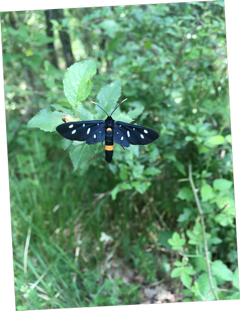
One living thing always contains all the sweetness of being. If you kill this living thing, you exile being. When I was young, I took the burnets for granted. A child knows that life is a gift made to create sweetness―until he learns that this gift has been revoked. My father called the burnet moths by an old-fashioned name which captured their reckless coloration: “Blutströpfchen”, “little specks of blood”. He was not a good father, but he loved the burnets, and so there is a small speck of light in his persona which I can love as well, the size and colour of a Zygaena filipendula flying off, stirring crimson with velvet blue-black.
If a butterfly is a metonymy of aliveness, no wonder it can be handed down the family tree as a token of reference―a source of life purified from all toxic ingredients that infiltrate human relationships. I remember the first time I went to the Apennines in summer with my own young children. We walked the dog every morning along the small mountain road behind the bed and breakfast we stayed in, and there, in the still morning air, were the burnets, clinging to the stalks of wild chicory like gems of priceless value, flying of and flickering through the air, bodiless and without purpose, a blessing of aliveness that wrapped its wings around my son and my daughter and me. It somehow packaged the ease and joy of those mornings forever into one gesture.
Still then, the burnets were ubiquitous. I took them for granted, as I took the summer, with its warm, but not scorching temperatures―the sweet European summer which seems to have gone about forever today. While I write this, I sit inside, windows closed against the heat, shades pulled tight, a fan stirring the air so I can work. Recently, I walked the same way I had strolled along with my kids on that summer holiday. The grass was burned. Few flowers raised their blossoms, the earth suffered thirst. I could find not a single burnet. They have been pushed away by a dystopian summer that makes every one of us, plants and animals, and ordinary citizens, yearn for a rain that never seems to come.
Even right at the height of their mating season, there were only a few. What does the fact that the image of eternal summer is fading away mean to our souls? We have to cope with a reality that is losing its most noble expressions, that has been hollowed out in the centre where it was most alive. I greet every burnet I see with a painful awareness of loss. The truth of the world that shows through the light of these creatures is closing unto itself.
In the Trentino region of the Italian Alps, burnets have all but vanished from the central Adige valley. They had been present there on low-intensity pastures and vacant areas well into the 1980s. Some of the Trentino burnets have retired to higher altitudes. But even there, they are becoming rarer, as the wind carries toxic residues from the industrial fruit cultures on the valley floor uphill. These moths are particularly sensitive to agrochemistry. Where they are still around is a healthy place. Human communities in the heavily cultivated Adige valley have become exceptionally wealthy. Few of their members have noticed the disappearance of the colourful moths. They have forgotten that when you are greeted by a burnet you receive a gift. The little moth offers you the certainty that you are in a place that provides life.
One past summer, I visited the place where Gustav Mahler, the Austrian composer, wrote the bulk of his middle and late symphonies, in a forest above Lake Wörthersee in Carinthia, on the southern face of the Alps. The lake is of an unearthly turquoise, a door of light to another realm. In this mystical landscape, Mahler retired to a small shed, his “composer’s hut” in order to write music. The little house from wood and stone today is open to visit.
What is music, if not yet another opening into the other side of the world? Like the burnets’ colour, it comes from that side which we can glean through our senses, but which reveals itself beyond these senses, because it consists of something that can only be grasped with an organ for inward meaning. Music is made on material instruments consisting of brass and wood and pig intestine and horse hair. It travels as an oscillation of the air to our ears, and makes our inner organs vibrate. But its meaning, its inwardness, is beyond that. It travels with matter, but shows us the flip side of solid things, just as the wings of the burnet do, which reflect the light not only as a physical wave, but as something profoundly essential to life.
Gustav Mahler was familiar with this perspective. He tried to echo back the inner essence through his music, as he repeatedly described to friends and colleagues. Mahler tried to dematerialise sound, to go through harmonies beyond harmonies to find the language of inwardness.
The composer had to walk from his villa at the lake shore to his work hut. He followed the shore, then crossed into open land at the foot of the hill that slowly led upwards, through shrubs and trees. When I followed his former path, clouds of light were stirred by each of my steps, so many burnets seemed to sit on the umbels of the flowers. They flew up, took some lazy flaps, and then settled again, wings stretched out, like little transparent doors into the centre where we are all meeting.
Thanks to Hannah Close for native language copyediting.
Andreas Weber
Berlin


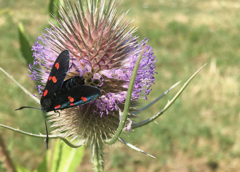
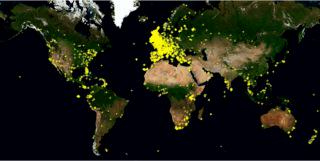


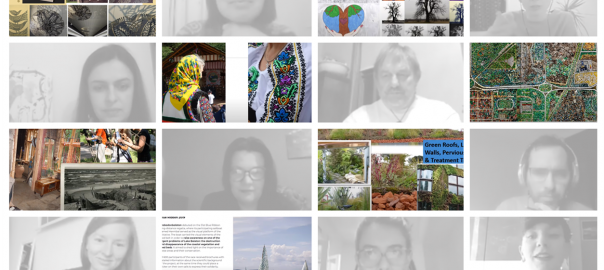
Leave a Reply